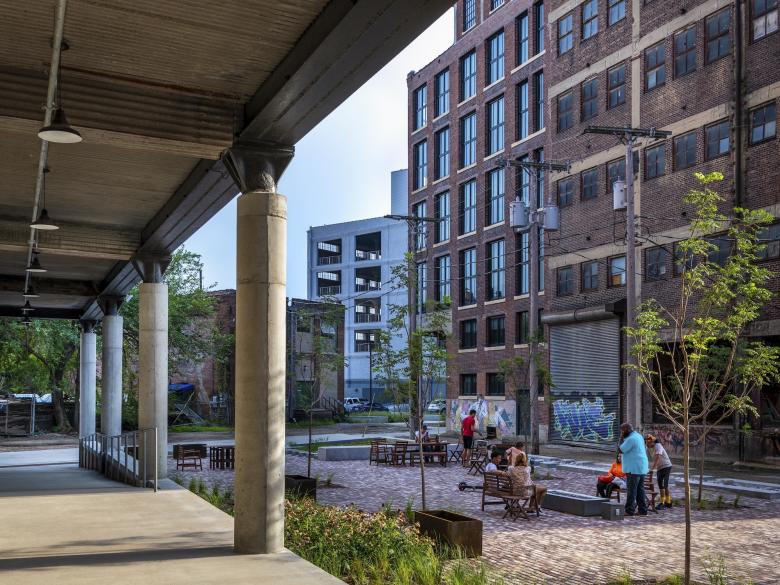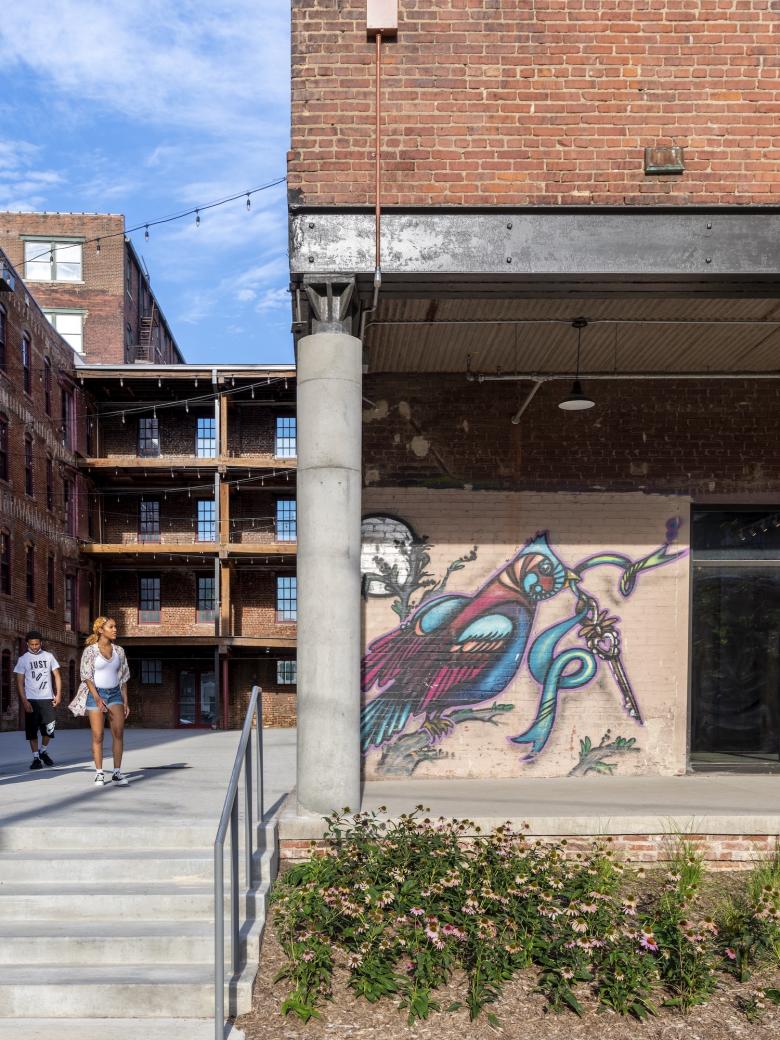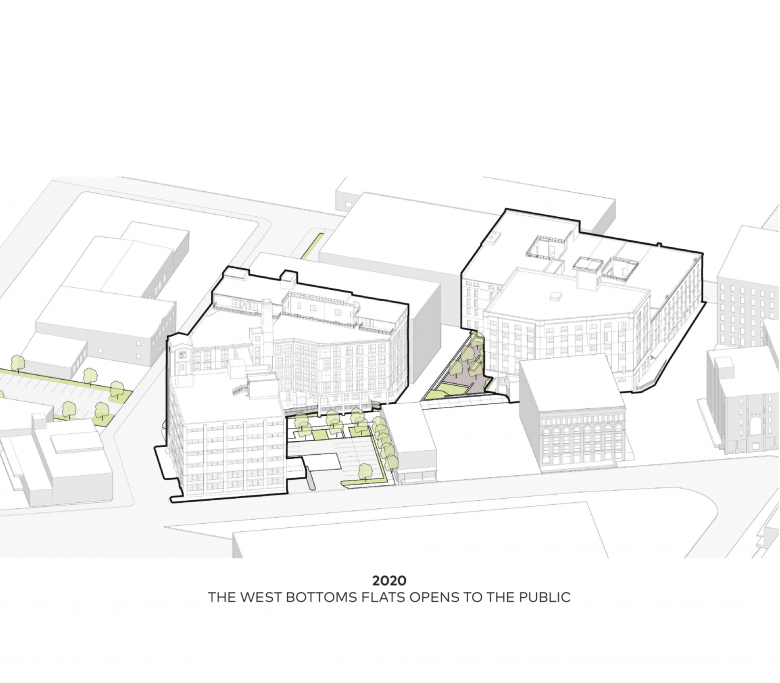US Building of the Week
West Bottoms Flats
BNIM
25. outubro 2021
Photo: Kelly Callewaert
BNIM describes West Bottoms Flats, their adaptive reuse of four historic warehouse and manufacturing buildings in Kansas City's West Bottom District, as "designing with a light touch." Now home to 265 residential units, the architects preserved many existing elements to make the project "feel like a place out of time." The architects at BNIM answered a few questions about the project.
Location: Kansas City, Missouri, USA
Client: MCM Company, Inc.
Architect: BNIM
- Design Principal: Craig Scranton
- Project Architects: Elvis Achelpohl, Alyssa Parsons
- Project Manager: Craig Scranton
- Project Team: James Pfeiffer, Janell Rock, Adam Wiechman, Ryan McCabe, Joyce Raybuck, Jeremy Kahm, Kylie Schwaller, Josh Harrold, Brian McKinney, Mark Neibling, Emily Thompson, Aaron Ross, Ruoxi (Cisy) Cao, Amanda Santoro
MEP/FP Engineers: KW Lang Hoss & Brown Engineers (Mechanical); Rodriguez Mechanical Contractors (Plumbing); Shaw Electric Company (Electrical); National Fire Suppression (Fire Protection)
Landscape Architect: BNIM (Adam Wiechman)
Lighting Designer: Derek Porter Studio
Interior Designer: BNIM (Janell Rock)
Civil Engineer: Taliaferro & Browne
Code Consultant: FP&C Consultants
Historic Preservation: HP Group
Brand Identity: Willoughby
Contractor: Rau Construction
Site Area: 160,000 sf
Building Area: 350,000 sf
See bottom for Important Manufacturers / Products.
Photo: Kelly Callewaert
What were the circumstances of receiving the commission for this project?BNIM was selected to lead the West Bottoms Flats project following our team’s response to an RFP (Request for Proposals).
Photo: Kelly Callewaert
Please provide an overview of the project.Working with MCM Company, Inc., BNIM led the adaptive reuse design of four unique historic warehouse and manufacturing buildings — Abernathy, Liberty, Wyoming, and Bemis — to help restore the West Bottoms District of Kansas City as a public realm for residents to live and work. The West Bottoms Flats transforms the existing buildings into 265 residential units, community courtyards, tenant amenities, ground-level commercial spaces, and a valet parking structure.
BNIM also focused on reestablishing vitality in the surrounding streetscape and landscape through outdoor courtyards and pedestrian-oriented design that features open-air art galleries of local street artists. With the West Bottoms District’s history of significant flooding, the team also worked with the Kansas City Missouri Water Services Department on a pilot Green Infrastructure project to develop innovative stormwater strategies in the courtyards and historic alleys.
Photo: Kelly Callewaert / Staging: Josh Nunez and Addison Ford
What are the main ideas and inspirations influencing the design of the project?With a history in Kansas City dating back to the 1800s, the West Bottoms District has been utilized as stockyards, an area of industrial investment, as well as a place of pedestrian and retail use. However, two damaging floods in the early- and mid-twentieth century resulted in nearly all economic and industrial activity to move away from the area. There have been positive efforts to help revitalize and transform of this historic district of Kansas City for modern day use over the years. The West Bottoms Flats is the first major project to move forward in transforming the North side of the West Bottoms District by adapting former warehouses for residential use with micro-units that provide an authentic sense of place and serve as a prototype for future residential development.
The design aims to celebrate and showcase the historic materials and patinas of the existing buildings, acknowledging the "urban ruin" quality of the project and site, while selectively removing portions of the interior floor plates within to invite fresh air and daylight into new living spaces. Retail, work, and publicly oriented resident amenity spaces enliven the ground level of the buildings, at both the street and alley frontages. The existing courtyards and alleys that connect the individual apartment buildings are refreshed with a light touch to serve as outdoor circulation and gathering spaces for the new inhabitants of the area. The site’s landscape mitigates problems with rainfall drainage inherent to the neighborhood through the introduction of rain gardens and underground stormwater detention.
Drawing: BNIM
How does the design respond to the unique qualities of the existing buildings?The design team aimed to create a revived atmosphere within the existing buildings while designing with a light touch to respect historical integrity. Reincorporation of historic beauty is evident in the use of reclaimed timber and other reuse materials, preservation of existing structural elements, high ceilings, and large windows that provide natural daylighting and offer expansive views of Kansas City and the West Bottoms District. The interior of the three apartment buildings necessitated a more intensive renovation, presenting the design team with the unique challenge to create residential function and value within the differing geometries and large floor plates of these historic former buildings that did not inherently harmonize with the scale of the proposed apartment units
The design was addressed by removing portions of floor and roof structure in the centers of three of the buildings to create new "light courts" that allow daylight and fresh air to permeate the buildings. Windows and doors are replaced with new historic replicas and former exterior loading bays are enclosed with floor-to-ceiling glass storefront to maintain their historic transparency.
Drawing: BNIM
A specialized feature among the West Bottoms Flats’ amenities is the apartments’ parking structure which includes a six-story car elevator. As one of few car elevators in Missouri, this future-thinking parking structure also meets historic adaptive reuse guidelines.
The design team aimed to introduce outdoor courtyards and pedestrian-oriented design to help reestablish vitality in surrounding streetscape and to heal the landscape. A large mid-block courtyard is one of a few remaining spaces in the West Bottoms that is completely framed by historic buildings, making it feel like a place out of time.
Located in a 100-year floodplain, the design team mitigated potential flooding issues by ensuring all ground-floor apartments are located at least three feet above adjacent grade. Additionally, $1 million was devoted to green infrastructure improvements in the outdoor common spaces and adjacent alleys, which direct all rainwater falling on the block into a 151,000-gallon detention system under one of the surface parking lots.
Drawing: BNIM
How did the project change between the initial design stage and its completion?The project remained relatively consistent from its initial design to completion. BNIM refined the original apartment layouts in our design development process, and the specific extents and locations of some of the selectively demolished "light courts" evolved as we better understood the buildings’ structural systems. The concepts involving selective demolition, smaller apartment sizes, and celebrating the historic materials and patinas of the existing buildings were there from the start of the project.
Drawing: BNIM
Was the project influenced by any trends in energy-conservation, construction, or design?Yes, the project’s developer wanted BNIM to include smaller apartment sizes (down to 350 square feet in some instances) in order to provide a range of price-points for prospective tenants. This was one of the first projects in Kansas City to include these "micro-unit" sized apartments.
In working with Kansas City Missouri Water Services Department on the Green Infrastructure plan for the area, the project also focused on capturing, storing, and infiltrating stormwater from the building roofs and the ground. Bio-filtration zones were cut into the ground in areas with poor drainage to alleviate flooding and take advantage of the underlying soils that have extremely high percolation rates, which also helps bring plant ecologies back into a post-industrial area.
Drawing: BNIM
What products or materials have contributed to the success of the completed project?- Abernathy: Existing brick walls; existing heavy timber columns and beams; existing wood joist floor structure; aluminum historic-replica windows; fiber cement lap siding; corrugated metal siding; LVT flooring; painted GWB
- Liberty: Existing brick walls; existing heavy timber structure; aluminum historic-replica windows; LVT flooring; Painted GWB
- Wyoming: Existing brick walls; existing concrete structure; aluminum historic-replica windows; James Hardie lap siding; painted GWB
- Bemis: Existing brick walls; existing concrete structure, bird netting
- Site: Reclaimed brick pavers; cast-in-place concrete runnels; native plantings; weathering steel grates; concrete pave-drain
Drawing: BNIM
Important Manufacturers / Products:- GE (Electric Range, Refrigerator, Hood, Dishwasher, Washer/Dryer Combo)
- Advanta (Cabinets – Studio Full Access series)
- American Standard (Toilet – Cadet Pro elongated)
- Duravit (Washbasin)
- Aquatic (Shower)
- Amtico (Vinyl tile)
- Johnsonite (Cove base)
- Garaventa Lift (Wheelchair lift – Series 3 Genesis Opal)
- Schindler (Passenger elevator)
Email interview conducted by John Hill.










